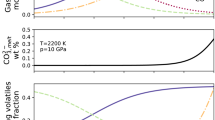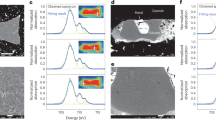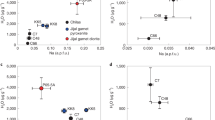Abstract
Magmatic outgassing of volatiles from Earth’s interior probably played a critical part in determining the composition of the earliest atmosphere, more than 4,000 million years (Myr) ago1. Given an elemental inventory of hydrogen, carbon, nitrogen, oxygen and sulphur, the identity of molecular species in gaseous volcanic emanations depends critically on the pressure (fugacity) of oxygen. Reduced melts having oxygen fugacities close to that defined by the iron–wüstite buffer would yield volatile species such as CH4, H2, H2S, NH3 and CO, whereas melts close to the fayalite–magnetite–quartz buffer would be similar to present-day conditions and would be dominated by H2O, CO2, SO2 and N2 (refs 1–4). Direct constraints on the oxidation state of terrestrial magmas before 3,850 Myr before present (that is, the Hadean eon) are tenuous because the rock record is sparse or absent. Samples from this earliest period of Earth’s history are limited to igneous detrital zircons that pre-date the known rock record, with ages approaching ∼4,400 Myr (refs 5–8). Here we report a redox-sensitive calibration to determine the oxidation state of Hadean magmatic melts that is based on the incorporation of cerium into zircon crystals. We find that the melts have average oxygen fugacities that are consistent with an oxidation state defined by the fayalite–magnetite–quartz buffer, similar to present-day conditions. Moreover, selected Hadean zircons (having chemical characteristics consistent with crystallization specifically from mantle-derived melts) suggest oxygen fugacities similar to those of Archaean and present-day mantle-derived lavas2,3,4,9,10 as early as ∼4,350 Myr before present. These results suggest that outgassing of Earth’s interior later than ∼200 Myr into the history of Solar System formation would not have resulted in a reducing atmosphere.
This is a preview of subscription content, access via your institution
Access options
Subscribe to this journal
Receive 51 print issues and online access
$199.00 per year
only $3.90 per issue
Buy this article
- Purchase on Springer Link
- Instant access to full article PDF
Prices may be subject to local taxes which are calculated during checkout



Similar content being viewed by others
References
Kasting, J. F. Earth’s early atmosphere. Science 259, 920–926 (1993)
Canil, D. Vanadium partitioning and the oxidation state of Archaean komatiite magmas. Nature 389, 842–845 (1997)
Delano, J. W. Redox history of the Earth's interior since ∼3900 Ma: implications for prebiotic molecules. Orig. Life Evol. Biosph. 31, 311–341 (2001)
Burgisser, A. & Scaillet, B. Redox evolution of a degassing magma rising to the surface. Nature 445, 194–197 (2007)
Cavosie, A. J., Valley, J. W. & Wilde, S. A. &. Edinburgh Ion Microprobe Facility. Magmatic δ18O in 4400–3900 Ma detrital zircons: a record of the alteration and recycling of crust in the early Archean. Earth Planet. Sci. Lett. 235, 663–681 (2005)
Cavosie, A. J., Valley, J. W. & Wilde, S. A. &. Edinburgh Ion Microprobe Facility. Correlated microanalysis of zircon: trace element, δ18O, and U-Th-Pb isotopic constraints on the igneous origin of complex 3900 Ma detrital grains. Geochim. Cosmochim. Acta 69, 637–648 (2006)
Watson, E. B. & Harrison, T. M. New thermometer reveals minimum melting conditions on earliest Earth. Science 308, 841–844 (2005)
Hopkins, M., Harrison, T. M. & Manning, C. M. Low heat flow inferred from >4 Gyr zircons suggests Hadean plate boundary interactions. Nature 456, 493–496 (2008)
Berry, A. J. Danyushevsky, L. V., O’Neill, H. St. C., Newville, M. & Sutton, S. R. Oxidation state of iron in komatiitic melt inclusions indicates hot Archaean mantle. Nature 455, 960–963 (2008)
Mallmann, G. & O’Neill, H. St. C. The crystal/melt partitioning of V during mantle melting as a function of oxygen fugacity compared with some other elements (Al, P, Ca, Sc,Ti, Cr, Fe, Ga,Y, Zr and Nb). J. Petrol. 50, 1765–1794 (2009)
Carmichael, I. S. E. & Ghiorso, M. S. The effect of oxygen fugacity on the redox state of natural liquids and their crystallizing phases. Rev. Mineral. 24, 191–212 (1990)
Cherniak, D. J., Hanchar, J. M. & Watson, E. B. Rare-earth diffusion in zircon. Chem. Geol. 134, 289–301 (1997)
Rubatto, D. & Hermann, J. Experimental zircon/melt and zircon/garnet trace element partitioning and implications for the geochronology of crustal rocks. Chem. Geol. 241, 38–61 (2007)
Thomas, J. B., Bodnar, R. J., Shimizu, N. & Sinha, A. K. Determination of zircon/melt trace element partition coefficients from SIMS analysis of melt inclusions in zircon. Geochim. Cosmochim. Acta 66, 2887–2901 (2002)
Hinton, R. W. & Upton, B. G. J. The chemistry of zircon: variations within and between large crystals from syenite and alkali basalt xenoliths. Geochim. Cosmochim. Acta 55, 3287–3302 (1991)
Sano, Y., Terada, K. & Fukuoka, T. High mass resolution ion microprobe analysis of rare earth elements in silicate glass, apatite and zircon: lack of matrix dependency. Chem. Geol. 184, 217–230 (2002)
Fu, B. et al. Ti-in-zircon thermometry: applications and limitations. Contrib. Mineral. Petrol. 156, 197–215 (2008)
Sato, M., Hickling, N. L. & McLane, J. E. in Proc. Fourth Lunar Science Conference Vol. 1 (ed. Grose, W. A.) 1061–1079 (Geochim Cosmochim Acta Suppl. 4, Pergamon, 1973)
Taylor, D. J., McKeegan, K. D. & Harrison, T. M. Lu–Hf zircon evidence for rapid lunar differentiation. Earth Planet. Sci. Lett. 279, 157–164 (2009)
Valley, J. W. et al. 4.4 billion years of crustal maturation: oxygen isotope ratios of magmatic zircon. Contrib. Mineral. Petrol. 150, 561–580 (2005)
Watson, E. B. & Harrison, T. M. Zircon saturation revisited: temperature and composition effects in a variety of crustal magma types. Earth Planet. Sci. Lett. 64, 295–304 (1983)
Coogan, L. A. & Hinton, R. W. Do trace element compositions of detrital zircons require Hadean continental crust? Geology 34, 633–636 (2006)
Schmitt, A. K. et al. Rapid cooling rates at an active mid-ocean ridge from zircon thermochronology. Earth Planet. Sci. Lett. 302, 349–358 (2011)
Cavosie, A. J., Kita, N. K. & Valley, J. W. Primitive oxygen-isotope ratio recorded in magmatic zircon from the Mid-Atlantic Ridge. Am. Mineral. 94, 926–934 (2009)
Herd, C. D. K., Borg, L. E. & Jones, J. H. Oxygen fugacity and geochemical variations in the Martian basalts: implications for Martian basalt petrogenesis and the oxidation state of the upper mantle of Mars. Geochim. Cosmochim. Acta 66, 2025–2036 (2002)
Frost, D. J. & McCammon, C. A. The redox state of Earth’s mantle. Annu. Rev. Earth Planet. Sci. 36, 389–420 (2008)
Hildreth, W. & Wilson, C. J. N. Compositional zoning of the Bishop Tuff. J. Petrol. 48, 951–999 (2007)
Kleine, T., Munker, C., Mezger, K. & Palme, H. Rapid accretion and early core formation on asteroids and the terrestrial planets from Hf-W chronometry. Nature 418, 952–955 (2002)
Tian, F., Toon, O. B., Pavlov, A. A. & De Stereck, H. A hydrogen-rich early Earth atmosphere. Science 308, 1014–1017 (2005)
Reid, M. R., Vazquez, J. A. & Schmitt, A. K. Zircon-scale insights into the history of a Supervolcano, Bishop Tuff, Long Valley, California, with implications for the Ti-in-zircon geothermometer. Contrib. Mineral. Petrol. 161, 293–311 (2011)
Trail, D. Watson, E. B. & Thomas, J. B. The incorporation of OH into zircon. Am. Mineral. 96, 60–67 (2011)
Watson, E. B., Wark, D. A. & Thomas, J. B. Crystallization thermometers for zircon and rutile. Contrib. Mineral. Petrol. 151, 413–433 (2006)
Ayers, J. C., Brenan, J. B., Watson, E. B., Wark, D. A. & Minarik, W. G. A new capsule technique for hydrothermal experiments using the piston cylinder apparatus. Am. Mineral. 77, 1080–1086 (1992)
Acknowledgements
This work was supported by the NASA Astrobiology Institute (grant no. NNA09DA80A to The New York Center for Astrobiology).
Author information
Authors and Affiliations
Contributions
E.B.W. identified the importance of investigating redox sensitive elements in zircon. D.T. designed the experiments and took measurements. D.T. wrote the manuscript and interpreted the data with significant contributions from E.B.W. and N.D.T.
Corresponding author
Ethics declarations
Competing interests
The authors declare no competing financial interests.
Supplementary information
Supplementary Figures
This file contains Supplementary Figure 1 and legend. (PDF 170 kb)
Supplementary Tables
This file contains Supplementary Tables 1-5 comprising: 1) Starting oxide compositions for experiments; 2) Glass compositions analyzed by electron microprobe for Experiments; 3) Zircon compositions analyzed by electron microprobe for experiments; 4) Calculated zircon-melt partition coefficients using the data in Tables 3 and 4 and 5) Compiled literature data used to construct Figures 2 and 3. (XLS 121 kb)
Rights and permissions
About this article
Cite this article
Trail, D., Watson, E. & Tailby, N. The oxidation state of Hadean magmas and implications for early Earth’s atmosphere. Nature 480, 79–82 (2011). https://doi.org/10.1038/nature10655
Received:
Accepted:
Published:
Issue Date:
DOI: https://doi.org/10.1038/nature10655
This article is cited by
-
Revisiting the Geochemical Classification of Zircon Source Rocks Using a Machine Learning Approach
Mathematical Geosciences (2024)
-
Zircon and the role of magmatic petrogenesis in the formation of felsic-hosted volcanogenic massive sulfide (VMS) deposits: a case study from the mid-Paleozoic Yukon-Tanana terrane, northern Canadian Cordillera
Mineralium Deposita (2024)
-
Hadean mantle oxidation inferred from melting of peridotite under lower-mantle conditions
Nature Geoscience (2023)
-
Oxygen-rich melt in deep magma oceans
Nature Geoscience (2023)
-
I-type and S-type granites in the Earth’s earliest continental crust
Communications Earth & Environment (2023)
Comments
By submitting a comment you agree to abide by our Terms and Community Guidelines. If you find something abusive or that does not comply with our terms or guidelines please flag it as inappropriate.



